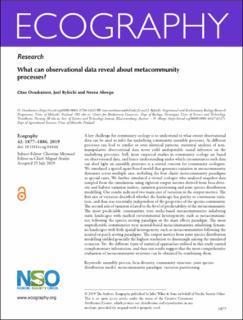| dc.contributor.author | Ovaskainen, Otso | |
| dc.contributor.author | Rybicki, Joel | |
| dc.contributor.author | Abrego, Nerea | |
| dc.date.accessioned | 2022-05-02T14:30:28Z | |
| dc.date.available | 2022-05-02T14:30:28Z | |
| dc.date.created | 2020-03-05T10:07:31Z | |
| dc.date.issued | 2019 | |
| dc.identifier.citation | Ecography. 2019, 42 (11), 1877-1886. | en_US |
| dc.identifier.issn | 0906-7590 | |
| dc.identifier.uri | https://hdl.handle.net/11250/2993701 | |
| dc.description.abstract | A key challenge for community ecology is to understand to what extent observational data can be used to infer the underlying community assembly processes. As different processes can lead to similar or even identical patterns, statistical analyses of non-manipulative observational data never yield undisputable causal inference on the underlying processes. Still, most empirical studies in community ecology are based on observational data, and hence understanding under which circumstances such data can shed light on assembly processes is a central concern for community ecologists. We simulated a spatial agent-based model that generates variation in metacommunity dynamics across multiple axes, including the four classic metacommunity paradigms as special cases. We further simulated a virtual ecologist who analysed snapshot data sampled from the simulations using eighteen output metrics derived from beta-diversity and habitat variation indices, variation partitioning and joint species distribution modelling. Our results indicated two main axes of variation in the output metrics. The first axis of variation described whether the landscape has patchy or continuous variation, and thus was essentially independent of the properties of the species community. The second axis of variation related to the level of predictability of the metacommunity. The most predictable communities were niche-based metacommunities inhabiting static landscapes with marked environmental heterogeneity, such as metacommunities following the species sorting paradigm or the mass effects paradigm. The most unpredictable communities were neutral-based metacommunities inhabiting dynamics landscapes with little spatial heterogeneity, such as metacommunities following the neutral or patch sorting paradigms. The output metrics from joint species distribution modelling yielded generally the highest resolution to disentangle among the simulated scenarios. Yet, the different types of statistical approaches utilized in this study carried complementary information, and thus our results suggest that the most comprehensive evaluation of metacommunity structure can be obtained by combining them. | en_US |
| dc.language.iso | eng | en_US |
| dc.publisher | Wiley | en_US |
| dc.rights | Navngivelse 4.0 Internasjonal | * |
| dc.rights.uri | http://creativecommons.org/licenses/by/4.0/deed.no | * |
| dc.title | What can observational data reveal about metacommunity processes? | en_US |
| dc.title.alternative | What can observational data reveal about metacommunity processes? | en_US |
| dc.type | Peer reviewed | en_US |
| dc.type | Journal article | en_US |
| dc.description.version | publishedVersion | en_US |
| dc.source.pagenumber | 1877-1886 | en_US |
| dc.source.volume | 42 | en_US |
| dc.source.journal | Ecography | en_US |
| dc.source.issue | 11 | en_US |
| dc.identifier.doi | 10.1111/ecog.04444 | |
| dc.identifier.cristin | 1799756 | |
| cristin.ispublished | true | |
| cristin.fulltext | original | |
| cristin.qualitycode | 2 | |

